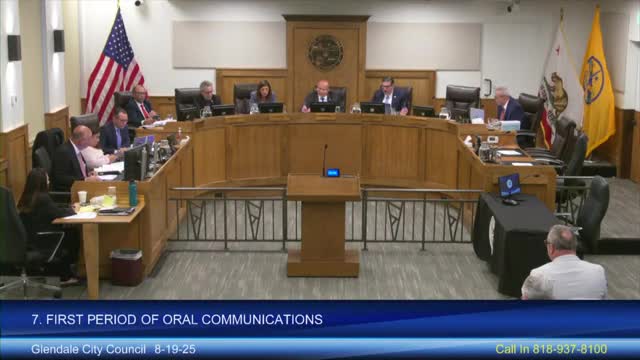Glendale City Council Adopts Ordinance to Lower Speed Limits on 21 Roadways
August 20, 2025 | Glendale, Los Angeles County, California
This article was created by AI summarizing key points discussed. AI makes mistakes, so for full details and context, please refer to the video of the full meeting. Please report any errors so we can fix them. Report an error »

In a recent Glendale City Council meeting held on August 19, 2025, members discussed a significant ordinance aimed at enhancing road safety by lowering speed limits on 21 roadway segments. This proposal, introduced during the previous council meeting, seeks to amend section 10.24.020 of the Glendale Municipal Code, which pertains to prima facie speed limits on non-local city streets.
City Manager, Mr. Galania, presented the ordinance, emphasizing its importance in addressing traffic safety concerns. The council opened the floor to public comments, receiving mixed reactions from community members.
Alan Dish, one of the speakers, expressed support for the measure, highlighting the potential benefits of reducing speed limits from 35 to 30 miles per hour. He argued that this change could encourage drivers to adhere more closely to the speed limit, thereby reducing the likelihood of accidents. Dish also shared a personal connection to the topic, referencing his Armenian heritage and the cultural significance of car culture in the community.
Conversely, Mike Mohill raised concerns about the necessity of lowering speed limits, questioning whether it would effectively address the root causes of traffic issues. He suggested that better driver education in schools could be a more effective solution, advocating for a return to formal driver education programs. Mohill also proposed a provocative idea of displaying wrecked cars in high-traffic areas to serve as a visual reminder of the consequences of reckless driving.
After hearing from the public, the council moved to adopt the ordinance, with a unanimous vote in favor. This decision reflects the council's commitment to improving road safety in Glendale, although it also highlights ongoing debates about the best strategies to achieve this goal.
As the city implements these changes, the council will likely continue to engage with community members to address their concerns and explore additional measures to enhance traffic safety. The discussions from this meeting underscore the complexities of urban planning and public safety, as Glendale navigates the balance between regulation and community needs.
City Manager, Mr. Galania, presented the ordinance, emphasizing its importance in addressing traffic safety concerns. The council opened the floor to public comments, receiving mixed reactions from community members.
Alan Dish, one of the speakers, expressed support for the measure, highlighting the potential benefits of reducing speed limits from 35 to 30 miles per hour. He argued that this change could encourage drivers to adhere more closely to the speed limit, thereby reducing the likelihood of accidents. Dish also shared a personal connection to the topic, referencing his Armenian heritage and the cultural significance of car culture in the community.
Conversely, Mike Mohill raised concerns about the necessity of lowering speed limits, questioning whether it would effectively address the root causes of traffic issues. He suggested that better driver education in schools could be a more effective solution, advocating for a return to formal driver education programs. Mohill also proposed a provocative idea of displaying wrecked cars in high-traffic areas to serve as a visual reminder of the consequences of reckless driving.
After hearing from the public, the council moved to adopt the ordinance, with a unanimous vote in favor. This decision reflects the council's commitment to improving road safety in Glendale, although it also highlights ongoing debates about the best strategies to achieve this goal.
As the city implements these changes, the council will likely continue to engage with community members to address their concerns and explore additional measures to enhance traffic safety. The discussions from this meeting underscore the complexities of urban planning and public safety, as Glendale navigates the balance between regulation and community needs.
View full meeting
This article is based on a recent meeting—watch the full video and explore the complete transcript for deeper insights into the discussion.
View full meeting
